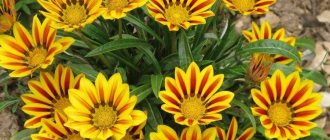Author: Elena N. https://floristics.info/ru/index.php?option=com_contact&view=contact&id=19 Category: Garden plants Published: February 14, 2019Last edits: November 03, 2020
- When to plant
- Growing conditions
- How and when to collect seeds
- Aubrieta deltoidea
plant (lat. Aubrieta), or aubrieta, belongs to the genus of creeping evergreen herbaceous perennial flowering plants of the Brassica family, numbering 12 species. Aubrieta is grown in rock gardens and gardens throughout Europe, and in nature it can be found in the Balkans, Italy, the south of France, Asia Minor and even in South America, where it lives on rocks and river banks. The flower received its Latin name in honor of the French artist Claude Aubrier, who worked in the genre of botanical illustration, and in our country it is called... windbag. The blooming aubrieta is a bright continuous carpet. A characteristic feature of the plant is that it retains its beautiful foliage even in winter.
Planting and caring for the shaving
- Planting: sowing seeds in open ground - in May or September. Sowing seeds for seedlings - at the end of February, planting seedlings in open ground - in the second half of May.
- Flowering: mid-spring to early summer, blooms again in autumn.
- Lighting: bright sunlight.
- Soil: poor, even rocky, but loose and permeable, containing peat or ash, with a pH of 6.0-7.0.
- Watering: moderate at the beginning and sparing as the plant develops. It is best to use the sprinkling method.
- Fertilizing: before flowering begins, with a solution of complete mineral fertilizer for flowering perennials; during the season, the soil is mulched 2-3 times with a layer of organic matter 3-5 cm thick.
- Pruning: After the first flowering, the stems are cut at the surface level of the site to stimulate the growth of new shoots.
- Reproduction: seeds and cuttings.
- Pests: aphids.
- Diseases: root rot, powdery mildew.
Read more about growing aubrieta below.
Why does the plant dry out and the leaves turn yellow?
A damaged root system of a garden crop may dry out if the plant is propagated by dividing the bush. The method is suitable for growing perennial aubrieta, but this option is used only in extreme cases, since the flower is quite difficult to tolerate the process of dividing the bush. As a result, the plant may die.
Green foliage may turn yellow as a result of overwatering the plant or when water gets on the leaf blade, which can cause leaf burn. The yellowing of green mass is affected by fertilizing the crop with manure or nitrogen fertilizers.
Botanical description
The aubrieta flower has an alternate leaf arrangement, the edges of its small, simple elliptical or obovate pubescent leaves are entire or serrated. Small four-petalled flowers of aubrieta, reaching 1 cm in diameter, violet, purple, red-pink, blue, and sometimes white, are collected in few-flowered racemes. Aubrieta blooms profusely and for a long time - from mid-spring to early summer. In autumn, with proper care, it blooms again. The fruit of the plant is a pod with flat brown seeds.
We devoted this article to a story about how to plant and care for aubrieta in open ground: how to plant aubrieta as seedlings, how to grow aubrieta on a windowsill, when and how to transplant aubrieta flowers to a flowerbed. You will learn all about the methods of propagation of aubrieta, as well as about diseases and pests that can threaten it.
Growing aubrieta from seeds
How to sow seeds
Aubrieta reproduces well by seed - seedlings and non-seedlings, however, growing Aubrieta by sowing seeds directly into the ground in May or September often leads to splitting of varieties. That is why we recommend you the seedling method as a more reliable one. Aubrieta from seeds blooms only in the second year. Aubrieta seeds can be purchased at any flower shop.
- How to speed up seed germination - make a heated container for seedlings with your own hands!
When to sow aubrieta seeds for seedlings? About two or two and a half months before the onset of heat - at the end of February. How to sow aubrieta? Sowing of aubrieta seeds is carried out in separate containers - peat tablets or peat-humus pots, in which you will then plant the seedlings in the ground. Seeds of 2-3 pieces are laid out on the surface of a moist substrate, covered with a layer of sand 3-5 mm thick on top, this sand cushion is moistened with a fine spray and the crops are placed under film or glass. The optimal temperature for seed germination is 18-21 ºC.
Seedling care
Growing aubrieta from seeds is a simple process. Ventilate the crops daily, moisten the soil as needed. Shoots usually appear after 3-4 weeks, and as soon as this happens, the coating can be removed. Be careful with watering: aubrieta seedlings do not like wet soil. Two weeks before planting in open ground, if it seems to you that the seedlings are developing too slowly, feed the seedlings with a solution of complex mineral fertilizers in low concentration.
Picking aubrieta
The plant does not tolerate transplantation very well, so growing aubrieta at home from seeds does not involve picking. In order to avoid intermediate transplantation of seedlings - picking - we recommended sowing seeds for seedlings in separate containers.
5.Transplant
Transplantation to a new place is carried out only when necessary - the aubrieta takes a long time to take root in a new place and becomes painful.
Transplantation is carried out in early spring or after complete flowering - in the second half of summer. There is no point in moving flowering bushes to a new place - they have already spent a lot of energy forming buds. Spring replanting can also negatively affect flowering. The autumn season should be carried out in such a time that the bushes have time to take root properly in a new place - about a month before the onset of the first night frosts.
When replanting, they try to minimally disturb the root system - they dig up and transfer the plants along with a lump of earth, without destroying it.
In a new place for the first time, water the flower regularly for 7-10 days, making sure that the soil does not dry out. It is also advisable at this time to protect the plants from direct sun, which will only add stress to them.
↑ Up,
Planting aubrieta in open ground
When to plant
Aubrieta is planted in a flowerbed when the return spring frosts have passed - in the second half of May. Approach the choice of site very responsibly: the aubrieta in the garden should receive maximum sunlight - only then will you be able to see truly abundant flowering of the aubrieta.
As for the soil, in this regard everything is very simple: the poorer the soil, the better for the plant. Aubrieta grows well between stone steps and concrete slabs. The soil should be loose, permeable and contain a small amount of ash or peat. As for the level of acidity, soil with a neutral or slightly alkaline reaction is preferable - pH 6.0-7.0.
How to plant
Aubrieta is a flexible plant, so you can plant it in accordance with your idea of what your flowerbed or rock garden should look like. The planting depth is determined by the length of the plant’s root system, the width of the holes is twice as large as the container in which the seedling grows. The distance between copies is at least 5 cm.
- Viburnum-leaved bladderwort: planting and care, varieties
If you grew seedlings in a ceramic or plastic container, before planting, place it in water and hold it until bubbles begin to appear on the surface of the soil - then carefully remove the plant with a lump of earth and lower it into the hole. After planting the aubrieta, compact the soil, mulch it with a 5 cm thick layer of sand and water it carefully.
Caring for aubrieta in the garden
Growing conditions
Growing an aubriet flower is an easy and enjoyable task. An adult plant needs watering only when there is a long drought. If you frequently water the aubrieta in normal summer weather, you can provoke an abundant growth of greenery to the detriment of flowering. Young plants need more frequent watering than mature ones, but even here moderation must be observed. The best way to water aubrieta is by sprinkling. After watering or rain, the soil in the flowerbed needs to be loosened and weeded.
During the growing season, it is recommended to mulch the soil in the flowerbed 2-3 times with a layer of sand 3-5 cm thick. In the spring, before flowering, and in the fall, the aubrieta is fed with a solution of complete mineral fertilizer for perennial flowering plants.
Caring for aubrieta involves pruning the plant after spring flowering almost to the level of the surface of the site - this measure promotes the growth of new shoots with fresh, bright foliage, which will be an excellent background for other flowers in the flowerbed or in the rock garden until the time comes for the aubrieta to bloom again .
Reproduction of aubrieta
As you can see, planting and caring for an aubriet flower is not difficult and does not require much effort. The plant can also be propagated simply by cuttings and seeds. We have already told you about the seedling method of growing aubrieta. But experienced gardeners prefer to sow aubrieta directly into the flowerbed.
Sow the seeds in well-moistened soil, dug to a depth of 15 cm, cleared of stones and weeds and seasoned with complex fertilizer, wood ash and lime (chalk). Sowing is not done too thickly; the seeds are not buried, but covered on top with a layer of sand 3-5 cm thick, which is carefully moistened with a watering can. Spring shoots appear in 10-20 days, and seeds sown in September will sprout only next spring.
Another way to propagate aubrieta is by cuttings. After pruning the plant in mid-summer, you will have plenty of plant debris to use as cuttings. Cuttings (cuttings of stems without flowers) are planted in a greenhouse in a substrate consisting of equal parts of peat and sand, and at the end of August, when they form roots, they are transplanted to a permanent place. Before winter, the seedlings have time to take root and grow stronger. If winters in your area are too harsh or unpredictable, keep the cuttings in a greenhouse until spring.
- How to pick petunia from a common container into separate cups
Propagation by dividing the bush is best tolerated by shaving in spring or autumn. This is a rather painful process for the plant. It is carried out according to the usual scheme: the bush is dug up, divided into parts so that each division has well-developed shoots and roots, after which the parts are planted in prepared holes. However, no matter how hard you try, a plant suffering from any transplant is unlikely to recover from such a complex procedure as dividing a bush, so we strongly recommend cuttings or seed propagation of aubrieta.
Pests and diseases
Planting and caring for aubrieta will not be a burden to anyone, especially since this plant is extremely rarely affected by diseases and pests. Sometimes aubrieta becomes infected with powdery mildew, a fungal disease, the sign of which is a whitish coating on the leaves and flowers of the plant, which becomes brown as the disease progresses. As a result of damage by powdery mildew, the aubrieta loses its decorative effect, its growth slows down, the diseased areas turn black and die, and the winter hardiness of the plant decreases. You can get rid of the disease by treating the plant with colloidal sulfur in accordance with the instructions.
Among the pests, the most dangerous for aubrieta is the aphid, a sucking insect that feeds on plant cell sap and spreads viral diseases. The pest is destroyed by treating the aubrieta with Fufanon, Karbofos, Arrivo or Biotlin. There can be from one to four treatment sessions - it all depends on the number of insects that have settled on the aubriet.
In general, aubrieta growing between stones is extremely rarely affected by diseases and pests.
Perennial aubrieta after flowering
How and when to collect seeds
For those who want to start seed propagation of aubrieta, we remind you that this method often does not preserve the varietal characteristics of the seedlings. But if you still want to get seeds from aubrieta, then after spring flowering, when you cut the stems, leave two or three shoots with ovaries on the bush, and when the seeds darken, cut off the pods, remove the seeds and ripen them indoors or sow them before winter in the way that we described to you.
Preparing for winter
If after the first flowering of aubrieta, experts recommend pruning the shoots, then after the second, in the fall, on the contrary, it is advisable to leave both the shoots and leaves for the winter and prune only in the spring. The perennial aubrieta overwinters well under the snow, but in snowless winters with sudden temperature fluctuations the plant may die, so just in case, cover it with dry leaves or spruce branches.
Rules for pruning plants
Pruning is a natural process for perennials. Plant pruning is divided into 2 types: decorative and health-improving.
The decorative look involves regular pruning of inflorescences, foliage and shoots that have dried out. This is necessary to improve the appearance of the plant and to direct the juices to the young shoots.
During health pruning, which should be carried out every spring during the flowering period, the shoots are cut to ground level. This is necessary so that new green shoots appear and flowering repeats in the fall.
Some gardeners prune the shrubs for the winter, but in most cases the procedure is not necessary. When cold weather sets in, the plant does not shed its leaves and can easily withstand prolonged frosts. It is best to cover flowers for the winter to prevent the shoots from rotting and preserve the appearance of the perennial.
Types and varieties
There are twelve species of aubrieta in nature, some of them are also grown in culture. Species such as white aubrieta, Croatian aubrieta, graceful aubrieta, Kolumka aubrieta are not frequent guests in our gardens, but some species are more widely popular. For example:
Aubrieta deltoidea
Or aubrieta deltoid - a herbaceous perennial, reaching a height of 15 cm, with deltoid gray-green leaves with one or two teeth on each edge. The purple-blue or lilac flowers of plants of this species, collected in loose racemes, reach 1 cm in diameter. Flowering begins in May and lasts a little more than a month. This species has been in cultivation since 1710, and is popularly called the “lilac bush.” Its variety of Bougainvillea with light purple flowers with an orange center reaches a height of 20 cm. Aubrieta deltoid served as the basis for breeding the most common species - Aubrieta cultivated.
Aubrieta x cultorum
Or hybrid aubrieta is a group of plants up to 20 cm high that overwinter under the snow. They have small jagged oblong leaves, lilac or purple flowers up to 1 cm in diameter. Modern varieties of cultivated aubrieta often have simple, double or semi-double flowers, and they reproduce well by seeds. There are varieties that can be grown in pots, some are even suitable for cutting. We present to you the most famous varieties of cultivated aubrieta:
- Cascade aubrieta is a perennial plant with flowers in blue, purple, turquoise, pink or red with a small yellow center. The leaves are gray-green in color and do not change color all year round;
- Charming Morocco is a lush and attractive plant with very large flowers for this crop - about 1.5 cm in diameter. Flower color ranges from blue to red and pink;
- Cote d'Azur - flowers of this variety, painted in the tone of heavenly blue, decorate the garden for two summer months, and in September they bloom again and bloom until frost;
- Giant Waterfall is a mixture of varieties - aubrieta violet, pink, red, lilac... On this winter-hardy perennial up to 15 cm high, flowers open with a diameter of up to 1 cm.
Aubriet varieties such as Carnival, Doctor Mules, Don, Gloriosa, Wanda, Blue King, Queen, Royal Cascade, Triumphant and others are also popular in culture.
Bright, fragrant, blooming living carpet
If you look at a photo of aubrieta, you can see a carpet of bright color, and if you also see this plant live, you can enjoy a pleasant, unforgettable aroma.
Recently, this flower has become one of the most popular perennial plants; it is often used by landscape designers to decorate flower beds and garden plots. What did he do to deserve such close attention to himself?











